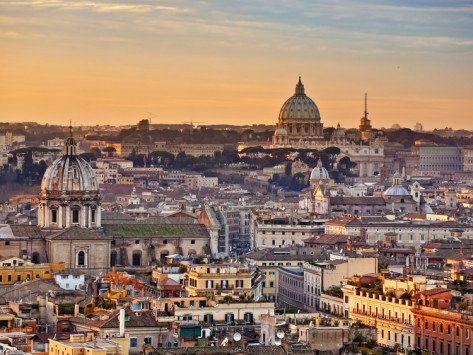View from Rome

One was dressed in the scarlet robes of a cardinal. The other wore traditional Islamic dress and the turban of an imam. The Archbishop of Westminster and Shaykh Ibrahim Mogra stood beside each other in the English College, Rome, in front of a plaque commemorating former students who had been martyred for the Catholic faith.
The pair were smiling, clearly at ease with one another. Cardinal Vincent Nichols and Shaykh Mogra, along with three other imams, had just returned to the college on the Via di Monserrato after a meeting with Pope Francis. Although it had been arranged some months ago, the sight of these religious leaders warmly greeting each other in friendship was a powerful expression of solidarity just two weeks after the Westminster terrorist attack.
The plaque listing the martyrs of the college was also a timely reminder that the Catholic Church in England and Wales has its own history of being persecuted, vilified and misunderstood as a minority religious community. It’s a memory still fresh in the mind of many Catholics, who can recall how their forbears had to struggle against the perception that they were “papists” loyal to a foreign power. This experience gives Catholics a special understanding of the feeling of being mistrusted that is shared by many British Muslims today: it prompted Cardinal Nichols to take the initiative and invite the imams to Rome. The meeting with the Pope, the cardinal told me afterwards, was about listening to the “voice of authentic Islam” and showed “what the true leadership of Islam aspires to, and is committed to”.
Shaykh Mogra was still beaming when I spoke to him several hours after his meeting with Francis. “I can’t believe I was there,” the Leicester-based imam said, with a North Midlands lilt. He explained how unfair it was to tarnish the whole of Islam because of the acts of a tiny few, and stressed that there is no justification for violence in Muslim teaching. He told me how appalled he is at the violence against Christians in the Middle East, and thinks Pope Francis should speak out over their plight when he visits Egypt later this month. This trip, all the more sensitive in the wake of the deadly Palm Sunday attacks on two Coptic churches, will be a vitally important moment for Christian-Muslim relations.
Pope Francis’ visit to Ireland next year and the appointment this week of a new papal ambassador to Great Britain throws into the spotlight an unresolved and potentially awkward diplomatic question: does the Holy See recognise the United Kingdom?
Last Saturday, it was announced that Francis had appointed career diplomat Archbishop Edward Adams to be his new apostolic nuncio to Great Britain. A nuncio plays a dual role: both the papal representative to the state authority and the Pope’s liaison with the local Church, with the key role of assisting in the selection of new bishops in that country. But while the Holy See describes their ambassador as covering Great Britain – meaning England, Wales and Scotland – he is accredited to the Court of St James’s and to the sovereign of the United Kingdom. Meanwhile, across the Irish Sea, there is a nuncio to Ireland, who helps select Irish bishops on both sides of the border, and who is the diplomatic representative to the government in Dublin, not to Northern Ireland.
Yet as far as the Foreign Office is concerned, the relationship is between the UK and the Holy See. The issue might become sensitive should Francis get his wish next year to become the first Pope to visit Northern Ireland.
Then there is the added complication of Brexit, which has placed new uncertainty over the border between Northern Ireland and the Republic. This, along with the possibility of Scottish independence, could force a Vatican rethink over its relationship with the UK.
Holy Week in Rome is colourful and dramatic, with the story of Christ’s Passion, death and Resurrection spilling out of church sanctuaries on to the streets of the Eternal City. On Palm Sunday green branches were tied to pillars outside churches; the Colosseum is lit up on Good Friday for a torchlight procession, while tourists – believing or not – gather for major celebrations in the same way as the crowds did 2,000 years ago. As has become his custom, Pope Francis has decided to take the Mass of the Lord’s Supper out of the Vatican: this year he was expected to wash the feet of inmates at a jail in Paliano, 40 miles south of Rome, known to hold ex-mafia members who have turned state witness.
In another Holy Week innovation, for the first time a laywoman, the French biblical scholar Anne-Marie Pelletier, has written the Stations of the Cross meditations for the Passion in the Colosseum. The married mother-of-three has described her reflections as “non-traditional”, with references to Christ uniting himself with suffering children.
Christ’s sacrifice on Good Friday leads to the new life of the Resurrection. And tomorrow the Pope will celebrate Easter Sunday Mass in a St Peter’s Square brought alive with a stunning floral display made up of thousands of tulips, hyacinths and daffodils.


 Votes : 0
Votes : 0









